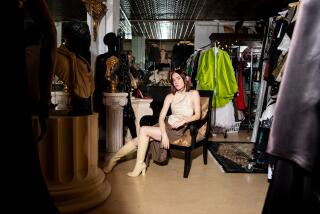Thea Porter; Innovator in Fashion
- Share via
Thea Porter, an influential London fashion designer who catered to the anti-status mood of the 1960s with the rich-hippie look and to the more laid-back ‘70s with opulent caftans, died of a lung infection in London on Monday. She was 72.
“I became a designer because I wanted perfection for others,” said the woman whose distinctive clothing was worn and collected by the likes of Elizabeth Taylor, Barbra Streisand and the empress of Iran.
Often intricately decorated, layered and hand-painted, Porter’s designs bore the exoticism of the Middle East, where she lived as a child. Born in Jerusalem and raised in Damascus, Syria, she was the daughter of an Irish Presbyterian missionary and his French wife. They sent her to school in England, but she flunked out of Royal Holloway College and rejoined her parents, who by then were in Beirut.
She took a job in the British Embassy library there, marrying economist and diplomat Robert Porter in 1953. For the next 14 years, she was an embassy wife, dutifully attending official functions.
But she also studied art, started to paint and enjoyed mixing with Beirut’s bohemian society of artists, often dancing until dawn in the city’s discos. That life eventually took its toll: Her marriage dissolved in 1967, and Porter, then 40, moved to London.
She opened an interior decorating shop in London’s Soho district, offering a collection of pillows made from Middle Eastern textiles, as well as antique caftans. Soon customers were begging her to design clothes. She outfitted members of the Beatles, the Rolling Stones and Pink Floyd.
When a picture of a colorful gypsy caftan she designed for actress Fenella Fielding appeared in the newspapers, she was flooded with orders. Porter, who had no formal training in couture, made the jump to fashion designer. Her Soho shop quickly became London’s hot fashion mecca.
Later she added shops in Paris, New York and Beverly Hills. Although most of the shops foundered because of her steep prices and lack of business sense, her client list resembled a who’s who of the international jet set: Taylor and Streisand, as well as Bianca Jagger, Raquel Welch, Joan Collins, Charlotte Rampling and Princess Margaret and other royalty.
By the early 1970s, she was hailed in the Los Angeles Times as “the woman whose clothes most epitomize the new spirit of London fashion.”
“At private clubs such as Regine’s, at private parties, at small discotheques, there are seemingly countless fashion extravaganzas by London’s Thea Porter. No soiree for the soignee set is complete, it would seem, without its fair share of long jeweled gowns or floating abayas with Porter labels,” The Times’ Marylou Luther wrote in 1974.
Porter’s creations were expensive--the cost of a caftan could be in four figures. But they were unabashedly beautiful, a romantic counterpoint to the dress-for-success pantsuits that also took hold in the fashion realm of the ‘70s. In the ‘60s, she started a trend when she put her hand-painted chiffon tops over mass-produced jeans, a combo that made hippie chic.
She favored softly sensuous fabrics--silk, brocade, chiffon, voile and velvet--often hand-painted, tie-dyed or embellished with spangles or braid. Once she was showing a long dress of silk sari fabric with multicolored threads that had been tie-dyed and woven into a gossamer web. It “might well have been a museum piece,” Luther wrote, adding that Porter was so passionate about her fabrics that she told a potential buyer of the dress to “make curtains out of it” when she was done wearing it so that the design would be preserved.
“I want my clothes to be like Fortuny’s fabulous pleated silk dresses,” Porter said. “A beautiful fabric should live forever. A woman should be able to wear it now, put it away and bring it back out again 40 years from now. . . . If it’s a good garment, it looks even better years later.”
“What I hate,” she said on another occasion, “is clothes that look new.”
Porter, who was diagnosed with Alzheimer’s disease in 1994, lived in a stylish apartment in the Mayfair section of London before moving to the Kensington nursing home where she died. She is survived by a daughter, Venetia.
More to Read
Sign up for Essential California
The most important California stories and recommendations in your inbox every morning.
You may occasionally receive promotional content from the Los Angeles Times.














